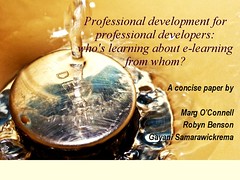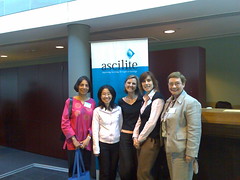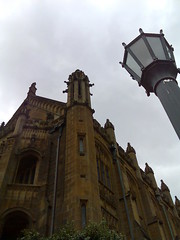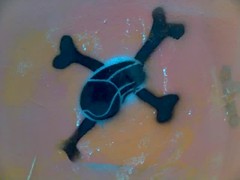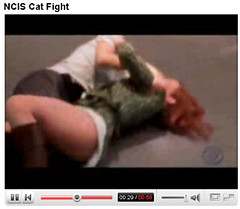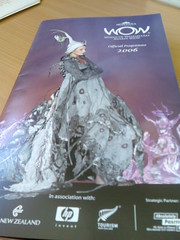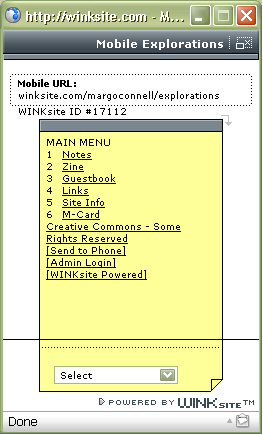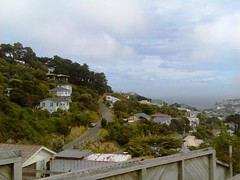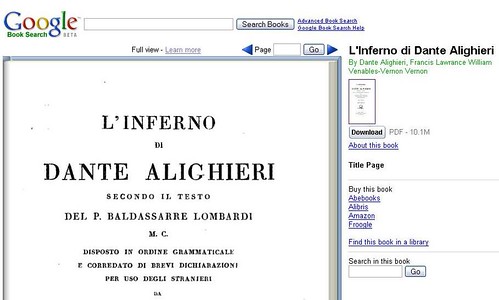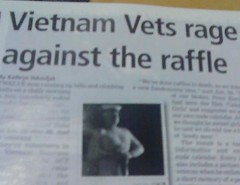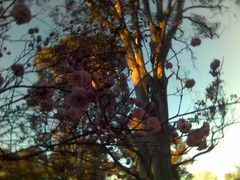Thursday, December 07, 2006
Who's learning about e-learning from whom? (ASCILITE 2006 paper)
Enjoy!
Wednesday, December 06, 2006
Reflection on ASCILITE conference themes (DAY 2)
- How do we define our educational design and taxonomies within educational design?
- Why are we not challenging what e-learning actually means and the e-learning created currently? Are we critiquing the work we do and the work of our colleagues sufficiently?
- Where are the students and the student 'voice'?
Listen to hear more of my reflections so far from ASCILITE 2006 in Sydney. Add your comments and questions too if you like...!
Tuesday, December 05, 2006
ASCILITE 2006 delta team reunited!
It was a great experience to present with most of the team once again, and we ran the presentation as we might have one of our development meetings, where we could model the consensus approach we used to inform our decision making process and continue the development of DELTA. We presented in a 'round-robyn' format, highlighting key points from participatory action research that framed our process and also informed our evaluation module where we collected our own reflections about DELTA and aspects of its development. We used our reflections alongside the data collected from other sources.
More about the paper and presentation via the ASCILITE site, but I'll also upload the slides for viewing here shortly.
Thanks to Robyn, Gayani, Charlotte and Sintie for their work on the presentation (Sintie for taking some photos!) and for sharing their reflections as part of the presentation. It was a good chance to look back on the experience, given it is the 1st anniversary after our disbanding as a team from CeLTS (closed end of 2005).
If you are interested to know more about DELTA, it has been re-launched from the Faculty of Medicine, Nursing and Health Sciences at Monash University and you can contact either Robyn or Charlotte for more details there.
More on day two shortly!
Monday, December 04, 2006
Uni of Sydney preASCILITE 2006
Wonderful to meet up with colleagues from around Australia and New Zealand, to share work tips and news from 2006! It's a buzz so far and we're barely into day 1!
So far, the first session of papers has looked at the use of role plays face-to-face and web-based...plus some uses of modularised learning objects developed with open source intentions, reusability and customisation.
Our presentation is on this afternoon, we're presenting collaboratively to highlight the participatory conversational process we engaged in (at Monash Uni) when developing an e-learning resource to showcase electronic learning and teaching approaches from across the uni.
Some neat features on trial: sms voting for the posters, and a "Dob in the Yobbo" (if you're familair with the cricket set up for this season, where crowd members at the cricket can do just that, if they feel a person is not behaving in the crowd!), for papers that may not have the best 'theoretical underpinning' or the delivery is not focussed enough! All light-hearted intentions of course!
There is also an ASCILITE blog, so far managed by Margaret Maag and a podcasting site using edublogs. Get in and have a look - you'll hear from some of the presenters themselves, plus delegates feedback during the conference and reflections about the presentations and all to do with the theme, "who's learning? Whose technology?"
Ciao for now!
Wednesday, November 29, 2006
Developing a mobile learning strategy?
Mark van 't Hooft at Mobile Learning Redefined « Ubiquitous Thoughts (via Leonard) points to some work by Mike Sharples and others re-examining mobile learning; what it means, what it requires and what strategies might be employed to develop mlearning approaches further.
I was drawn to the three foci quoted below outlined by van 't Hooft :
Mike Sharples wrote a nice piece about this in October 2005, entitled "Re-thinking learning for the mobile age." In it, he discusses three foci of the Kaleidoscope special interest group on the Philosophy of Technology Enhanced Learning:
1. distinguish what is special about learning in the mobile age compared to other types of learning activity.
2. a theory of mobile learning must embrace the considerable learning that occurs outside classrooms and lecture halls.
3. we must take account of the ubiquitous use.
These appear to me to be the overarching points with which to develop mobile learning strategies for organisations, communities, schools, networks and so on. These points allow us to critique our motives, structures and approaches to learning generally and our learners - as lifelong learners - more specifically.
How many organisations have a learning strategy, let alone a mobile learning strategy? What about a flexible learning plan? Or an elearning philosophy? What type of strategic plan does your organisation have?
....and this is fast becoming a mantra around my workplace: it is the learner who is mobile, not the technology!
technorati tags:mike.sharples, mlearning, learning, strategy, mobile, projects, sharples, mobile.learning
Blogged with Flock
Saturday, November 25, 2006
Group work: why not ask your students?
This via Stephen Downes...
Konrad has been reflecting on the use of group work after some feedback from teachers, parents and students at school.
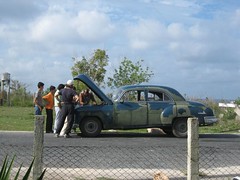
Image: Lilia Efimova
English 8, 2006-07 » Group Work: Good or Bad? In this link you can read some points about the pros and cons of group work as year 8 students explain.
Some of the points from the students that stood out for me:
- maybe people just don?t like group work because they are not able to communicate and share their ideas with others.
- there is another type when you have to make sure that you have done something and try and trick others into showing that you have actually done something.
- if people are trained to put their brains together, to give different ideas, then a project could almost always go further.
- Group work will help people to cooperate with people you don?t like and it is very important because even when you go to work when you are old, you will still be doing group work all the time.
- My conclusion is not that group work is better than Individual work, but group work can teach students which can?t be taught by always working individually. i also agree on how Konrad Glogowski said about group works making the class noisy and de-concentrated.
Well-considered points don't you think? And these are just a few!
How do your students find group work? What dynamics stand out for you as a teacher or as a learner?
All this reminds me that we need to remain critically aware of the strategies we employ in our teaching and learning and not take things for granted - one size doesn't fit all!
technorati tags:groupwork, student.voices, konrad.glogowski
Blogged with Flock
Student voices: dealing with real issues
Reality Check - information on youth mental health
Here's a step in the right direction. Students helping themselves help each other. Found this in the weekend Canberra Times (25/11/2006, News p.13).
Students have helped develop a website exploring and exposing the ins and outs of body image.
Karin MacDonald, Brindbella MLA helped launch the website recently, along with editor of Lip Magazine, Rachel Funari.
"Media Check encourages youth to resist media hype by creating and publishing your own media messages relating to mental health and well being"
Just another positive of the read/write web wouldn't you think?
technorati tags:students, voices, media, web, learning, mental.health
Blogged with Flock
Friday, November 03, 2006
Movember - all for men's health
At the start of N(M)ovember guys register with a clean shaven face. The Movember participants known as Mo Bros then have the remainder of the month to grow and groom their moustache and along the way raise as much money and awareness about male health issues as possible.
Our FLS team are going to participate, starting with Col (onya Col!) - you can check out his mo log (blog) and if you feel the urge to sponsor ($$$) him for his mo-tastic efforts during the month of November, then please do!
Ladies, you can also participate - mo sistas are welcome and can raise awareness of mens health issues too! :o)
From the Movember site, here are the key men's health issues for Movember 2006:
Prostate Cancer in partnership with the Prostate Cancer Foundation of Australia (www.prostate.org.au) because every year in Australia 2,700 men die of prostate cancer - more than the number of women who die from breast cancer.
Male Depression in partnership with Beyond Blue (www.beyondblue.org.au) because one in six men suffer from depression at any given time but most don't seek help.
Testicular Cancer because it?s the second most common cancer in young men aged 18 to 35.
So, here's a new (follicle) challenge for you... If you feel the urge, join up yourself and invite your own sponsors for this great initiative!
Blogged with Flock
Thursday, October 26, 2006
Welcome to the News at Seven!
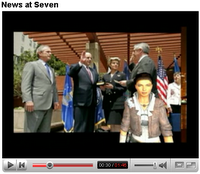
News at Seven is a neat way to present RSS news feeds audiovisually, which can also link to bloggers comments (in this example at least). This is a project from InfoLab, Northwestern University in the US.
And for learning? How about a student "newspaper" or student project updates, or learning activities in the workplace, as well as local community updates, beamed via internet and pulled down by users to their computers or mobile devices via RSS? Sounds pretty feasible to me! Could you see this audiovisual type of RSS applying to your teaching context?
This from the News at Seven project website:
More videos can be found here.News At Seven is a system that automatically generates a virtual news show. Totally autonomous, it collects, parses, edits and organizes news stories and then passes the formatted content to an artificial anchor for presentation. Using the resources present on the web, the system goes beyond the straight text of the news stories to also retrieve relevant images and blogs with commentary on the topics to be presented.
Friday, October 20, 2006
Freire Friday: Censorship, community, control and cat fights
One of the characteristics of oppressive cultural action which is almost never perceived by the dedicated but naive professionals who are involved is the emphasis on the focalized view of problems rather than on seeing them as dimensions of a totality.-- Paulo Freire, Pedagogy of the Oppressed (1972, p.111).
It was reported in the news earlier this week that YouTube contained numerous recordings from mobile phones of school fights. Adolescence psychologist, Dr Michael Carr-Gregg, slammed the service for allowing this type of stuff to be made widely available, citing that children should be protected from this type of voilence on YouTube, to avoid "copycat" behaviours, and that the service should be shut down, or at least blocked to young people by their parents.
Hmmm, sounds similar to the not-so-recent turkey-slapping episode on Big Brother (Australia) which saw two male contestants being booted out of the house for their actions towards a female participant, and parliamentarians, including PM John Howard, calling for the axing of the show.
Leigh Blackall raised the phone recording of school fighting phenomenon in his recent talk at the Global Summit 06, with the point that we are so wrapped up in the pervasiveness of the technology that we aren't seeing the fact that our schools are becoming increasingly dangerous places for our children - and it's the children who are capturing this evidence on behalf of their parents, teachers, prinicipals, members of parliament, social workers, counsellors, police officers, and our many other community support and advocacy networks.
So, what are they doing about it? Daming YouTube and side-stepping the real problems alive in our schools! Where's the critical and considered discussion about what is actually being recorded on these services and shows?
We are accepting of what appears on our TV screens of an evening too - this little beauty was captured from the TV show NCIS - some parallel huh?! It's like saying a gun is a 44 Magnum, not a shotgun and then paying no attention to the consequences of a shooting!
As Carmel Egan reports in The Age, these "trends" illustrate similar issues that are apparent in our society - our TV shows, movies, news, documentaries, YouTubes, Google Videos, BlipTVs, Bloggers, WordPresses, Odeos, and so on... are all representations of Self and Society. We reflect in our everyday the everyday actions and beings we are.
So, if we don't like what we're seeing, don't shoot the messenger - seek out the heart of the problem and make a choice to do something about it![schooling], [censorship], [schoolchildren], [control], [YouTube], [BigBrother], [Freire]
Thursday, October 19, 2006
Exploring the possibilities of weblogs
This was an example phonecast to demonstrate both the capabilities of using weblogs with mobile devices and to illustrate the powerful sense of immediacy of the tools and the actions taken in using the tools.
Friday, October 13, 2006
Freire Fridays: leadership through dialogue
 The correct method for a revolutionary leadership to employ in the task of liberation is, ... not 'libertarian propaganda'. Nor can leadership merely 'implant' in the oppressed a belief in freedom, thus thinking to win their trust. The correct method lies in dialogue.
The correct method for a revolutionary leadership to employ in the task of liberation is, ... not 'libertarian propaganda'. Nor can leadership merely 'implant' in the oppressed a belief in freedom, thus thinking to win their trust. The correct method lies in dialogue.- Paulo Freire, Pedagogy of the Oppressed, 1971, p.42
Even the tiniest revolution makes a difference. It's communicating them for the benefit of others that's the challenge, as I see it. You may have seen many leadership styles in your time, across a number of institutions. In today's climate of economic 'rationalisation', we have seen some forms of leadership being brought into question by a range of stakeholders, especially in our education systems.
What is a good leader to you? I favour the leader who supports her staff in the background, who practices humility in the face of myriad pressures, and who has a strong sense of self to back not only her team but her own ways of doing and being; all the while sustaining an ongoing conversation with those she meets. How is dialogue a key factor for good leadership then?
Just some loose thoughts on this summery Friday evening...! :o)
Image by chook poo
Tuesday, October 10, 2006
WOW - art on your skin
If you haven't yet travelled to New Zealand, Wellington especially, then this is the best excuse for a trip, if you ever needed one! I can't recommend this cultural event enough! :o)
We were even warmed up to the show by a WOW street parade and 12-foot-tall dancing butterflies!
This is a truly international event and a great cultural arts drawcard for NZ. Hats off to all involved, especially the amazingly talented designers - what vision!
Haiku, mobile learning and the practice of writing
"Mmmm, you could create a form of mobile-audio Haiku though," continued that voice in my head.Long conversations
beside blooming irises -
joys of life on the road
Matsuo Basho
Seeking - Walking the streets (Sept 26th, 2006)
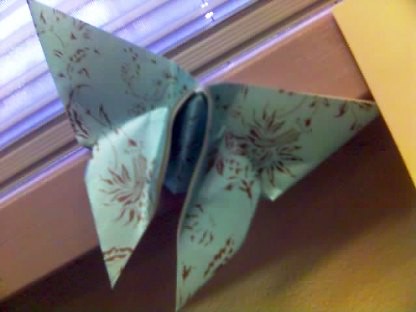 Marica at Seeking reflects on the use of audioblogging, after my spending time in Wellington with her and her colleagues at the Open Polytechnic of NZ. I was particularly drawn to her thoughts about the Haiku and how a short piece of writing can convey much (in a similar way to an image that speaks a thousand words I suppose).
Marica at Seeking reflects on the use of audioblogging, after my spending time in Wellington with her and her colleagues at the Open Polytechnic of NZ. I was particularly drawn to her thoughts about the Haiku and how a short piece of writing can convey much (in a similar way to an image that speaks a thousand words I suppose).
It seems easiest to liken haiku to a photograph, which captures a moment in time. A pure photograph describes a scene, and this description causes an emotional response in its viewer. There is no caption on the photograph that tells us what emotional response we are to take from it. It is instead a simple moment in time, unencumbered.Haiku is the same thing. When a butterfly lands upon an open flower, what does the haiku poet take from this? The same thing that his reader will take from it when he describes the moment in verse. But he trusts his reader to sense the same emotion from his accurate description of the scene. He does not need to say "How beautiful!" in reference to the moment, because his words should evoke the correct response in his reader.
I often have jottings and snippets or phrases dotted around my desk on sticky notes, or written messily into notebooks (like my A5 laptop for example!) - even noted quickly in my mobile phone - and these hold meaning for me in ways a well-structured sentence may not.
Thus, from little things big things grow, as they say!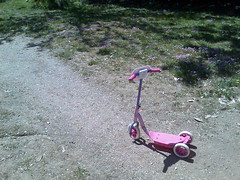
I'll leave you with my try at a haiku:
Live out loud and soft:
Expect a newness within
Greet the world in song.
technorati tags:haiku, mobile, mlearning, seeking, marica.sevelj, winksite, writing, prose, poetry, learning, practice
Blogged with Flock
Monday, October 09, 2006
Saturday, October 07, 2006
Blended learning: an RSS metaphor
The only true voyage . . . would be not to visit strange lands but to possess other eyes, to see the universe through the eyes of another, of a hundred others, to see the hundred universes that each of them sees. ?Marcel Proust
Blended learning -- blended learning -- blended learning?
For so long now we've considered blended learning to be the most useful way to draw together online and face-to-face approaches. We've come to understand (or at least feel comfortable with) blended learning as it draws together people and resources in a range of settings and formats...but, have we really blended learning?
It seems much of our blended learning practices are about modes of delivery and formats of resources (see this example, by Namit Kishore, NIIT). Have we limited our view and potential to be able to really blend or hybridise learning opportunities? Where are the learners?
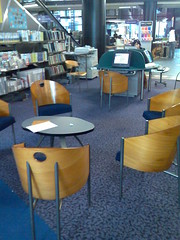
At the recent eFest conference in New Zealand, Diana Oblinger (Educause) presented a keynote speech about the changing face of learning that included - more than ever - informal learning and increased diversity of learners in increasingly blurred learning settings where work, study and life collide. Oblinger began her presentation with these words:
One student walks across campus listening to an iPod; another is engrossed in text messaging on her cell phone. During class, they're Googling, IMing and playing games?often at the same time. More likely to use the library as a gathering place than a resource, this is the Net Generation. They co-exist beside older students who are juggling work, childcare and eldercare. Do we understand our learners? What do their experiences, attitudes and expectations mean for educational institutions?
Indeed, are we listening to what we are seeing in our learners?
There are recent efforts by some educators to tackle aspects of blended learning, responding with more fluid and open learning designs and spaces for diverse learners' needs, that also value personalised learning approaches. I agree with Oliver and Trigwell (2005) that we need to "radically reconcieve" the phrase, and re-centre the learner as key to a blended learning philosophy, "by exploring change [and patterns of change?] from the perspective of the learner" (p.24).
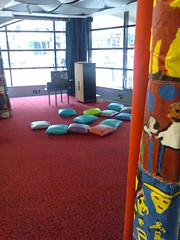
We need to look at what is being blended and why, and I considered this while listening to Oblinger's keynote at eFest. I think blended learning must involve recognition of
- multiverses
- learning spaces (more commentary on learning space design here and here)
- diverse and differing values of people
- relinquishing the term 'roles' in favour of a less abstracted notion of being in the world.
Oblinger described a number of learning processes, concepts and settings that speak to a more enlightened view of blended learning. She described projects like the Learning Spaces Project at Denison University, as an illustration of practical aspects of blending learning that move beyond simply delivery considerations. The TLT Group also present some non-traditional ideas about the development of approaches and spaces that enable blended forms of learning. These forms recognise the value of
- communication and making connections with other people
- provide basic and necessary infrastructure to allow learning to occur
- share (increasingly scarce) resources appropriate to the learning taking place
- encourage learners to interact spontaneously
- draw on moments of serendipity
- allow facilitators to pick up on motivations of learners and tailor instruction/guidance as a result
- space becomes interactive, multi-sited, 'porous' and dynamic.
These days the Internet is our information universe, as Oblinger described it. For many, the Internet has become a personalised learning space; flexible, dynamic, fluid and connected.

(Image by Mobology)
In light of this, I liken a refreshed definition of blended learning to RSS. Stephen Downes (in his eFest keynote) described RSS as a 'mess' of technologies (of which there are a number of variations). We use RSS to 'pull' information and services to us to suit our individual needs and preferences. RSS is a good metaphor (as well as a technical tool) for understanding ways in which learners can pull together threads of learning to create a blended setting in which learning occurs - elements loosely joined. We could very well view learning as a 'pull' activity, dependent on the learner's preferences and needs at the time. A learner can 'RSS' types, formats, contacts (activities, networks, resources), blending their own learning environment.
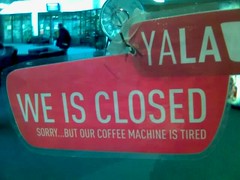
Concluding questions...
As we continue to debate the future(s) of learning, Downes additionally challenges us with the notion of an alternative education system that is publicly funded and open to all, "that could be tapped into by traditional institutions, if they choose". Is it possible it could be something like this?
- An 'RSS-ed' view where the learner draws together threads/services (metaphorically and technically) to create their own learning space, complete with people, resources and contextualised information?
- Should we be thinking more about future scenarios that are set to challenge the relevance of our current systems?
- Do we attempt to eat our current systems from the inside-out OR must we take the party elsewhere?
- Should our institutions operate more like 'containers' for supporting learning spaces (through provision of infrastructure), motivated more by the learners' needs and less by curriculum?
- Will there come a day when we can say "ACME Institute works for me?"
- Will education return to being a (publicly-funded) service supporting people, instead of a business focused on 'user pays' and 'the bottom line'?
- How do we engage with the tensions of education in a networked society?
References
Downes, S. (2006) Keynote address, eFest 2006, September 27-29, Wellington, NZ.
Kishore, N. (2002) Blended learning - Fixing the mix, NIIT Technologies.
Oblinger, D. (2006) Keynote address, eFest 2006, September 27-29, Wellington, NZ.
Oliver, M. & Trigwell, K. (2005) Can 'blended learning' be redeemed? E-Learning, 2(1), 17-26.
Images by margoconnell, unless otherwise stated.[blended_learning], [open_education], [flnw], [oblinger], [downes], [efest_2006]
Wednesday, October 04, 2006
OLT Conference 2006 : Learning on the Move
Whilst I was in New Zealand last week, my colleague Leonard attended the OLT Conference in Queensland, where he presented our paper, Learner-centric design of digital mobile learning.
We received the Best Paper Award! Thanks to the reviewers and the conference chairs for their support!
Other OLT2006 papers can be accessed here. I'd be interested to hear your thoughts about our paper ...Mobile Learning » Learner-Centric Design of Digital Mobile Learning
technorati tags:OLT, mlearning, conference, 2006, queensland, newzealand, award, paper
Blogged with Flock
Tuesday, October 03, 2006
Brainstorming the interactive podcasting idea
At the end of the day I discussed the idea with Marica and Lynsey and lots of questions surfaced, mainly around the idea of rights of the originating 'author' and how some people may or may not be comfortable with the idea of having others 'annotate' their thoughts and writing (or audio) in this way.
These questions appear in the comments of the Flickr photo posted by mobology. The image is of my A5 "laptop" (and was very effective!).
Interactive podcasts - asynchronous audio activities?
interactive podcasts - blip.tv (beta) (thanks to Leigh for this recording).
I envisaged something like this because being a somewhat kinaesthetic learner, I like to 'do' as I listen and read things. So for me, being able to interrupt a conversation (or podcast) and make notes to prompt or clarify my own thinking, would be really useful and very timely. In most cases, I would do this manually anyway.
However, what if, when listening to a podcast, you were able to record your notes or questions or responses so that others could also listen to them along with the original podcast? You would effectively be adding your voice to the conversation! Really it could be called a conver-cast (emphasising the conversational element) and would occur in a 'layering of time'. The conversation occurs asynchronously and potentially combines
- discussion/chat
- podcasts
- commentary
- multiple voices
- remixing (perhaps copy and paste?)
- perhaps a wiki-like feature like rollback to previous versions (see comment by botheredByBees on BlipTV).
How might this be applied to learning situations?
I could imagine the 'lecture' for example, being podcasted, then students having the ability to zero in on a point being made, add a question, seek clarification, offer an opinion, and add to the 'lecture' in some way. This takes a linear 'one-way' resource and makes it inherently shareable, relevant to a learner's position of learning at a certain time. The podcast is recorded at one point in time, the learner's response may not take place until some time after (even after the course of study is finished). And it also allows for people to 'change their minds', as we often do in conversation where we can come around to another's point of view, for example.
Similarly, a facilitator could also present an 'unfinished' cast, where they begin a 'story' for example and invite learners to develop the cast over a period of time (like contributing to a wiki in a sense).
Exploring the possibilities...
What other situations might a conver-cast be effectively applied? What are the implications of such an approach? What other learning scenarios could be supported here?
I'd like to hear more from you - are their ramifications? Limitations? Other possibilities you see?
These are jsut some beginning thoughts...
technorati tags:podcasts, learning, flnw, wellington, newzealand, convercasting, conversation
Blogged with Flock
Saturday, September 30, 2006
Friday Sept 29: Farewell Wellington, NZ
Some key points I discuss in this post include:
- the torrent of visual metaphors for learning I see around me as I record this post,
- the possibilities for further conversations about developing networks and knowledge sharing, and
- generation 'I' and the need to pursue personalised learning in both informal and formal learning settings.
Thursday, September 28, 2006
Thursday Sept 28, Blogs and learning - a conversation (eFest 2006)
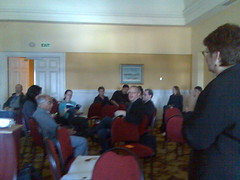 Thursday September 28, saw Marica and I run a conversation on 'blogs and learning' at eFest 2006, Wellington NZ. This audio post (below) explores our initial reactions and reflections about the session just after it had finished.
Thursday September 28, saw Marica and I run a conversation on 'blogs and learning' at eFest 2006, Wellington NZ. This audio post (below) explores our initial reactions and reflections about the session just after it had finished.
We set up the session details on this wiki page and have invited session participants to continue the conversation, to explore the idea of using blogs in learning settings. So, if YOU were there - we'd love to hear from you!
Also, if you'd like to run a session like this, we have included the activity structure on the wiki - you're welcome to use it. And we'd be interested to hear how your session goes! :o)
Some key points we shared immediately after the sessions included:
- the fact that people raised so many questions about ways of using blogs,
- that spam is unavoidable (our 'spammer' interrupted the session with flouro pink stick notes!), and
- that there is a need for some guidance for learners as to how effectively a blog can be used for learning.
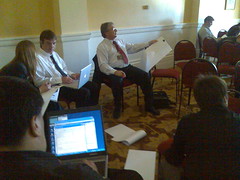 It's also quite a task to define what a blog is, because from the comments I heard from many of the participants who use blogs, they are as varied as the bloggers themselves! Another good call for personalised learning support methinks!
It's also quite a task to define what a blog is, because from the comments I heard from many of the participants who use blogs, they are as varied as the bloggers themselves! Another good call for personalised learning support methinks!Tuesday, September 26, 2006
Tuesday Sept 26: A cross-fertilisation of ideas (Open Polytechnic)
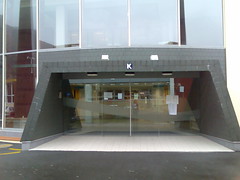
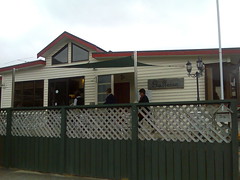
I conducted a conversation at the Open Polytechnic about the current goings on in the Australian Flexible Learning scene and how it was preparing us for a future of learning. There was some exchange of ideas and experiences, some similar and some quite different. My wiki has a mash-up of presentation notes available.
Thanks to the Open Polytechnic staff for welcoming me into their workplace, and for sharing their experiences - in particular, Brent, Sue, Linda, Jerome, Judy, Anouk and Marica - I really appreciated it! I will be in touch with more questions shortly (especially about Moodle Linda!) :o)
Monday, September 25, 2006
Wellington NZ, a dramatic welcome!
The coastline as is wild as the wind buffering it. The plane flew straight over a row of weatherboard houses that stood unprotected on the end of the country, their gay colours defying the elements that beat against them.
What a dramatic welcome! I'm really struck by the drama of the place. Houses climb the hills, scrambling to get a good footing to keep their residents safe; trees and shrubs, dark green, yellow and orange, lock themselves to the hillside huddling together for support against gravity and the wind.
The wind - well, yes, I was warned about the wind, but you can tell me till you're blue in the face, but until I've 'been there' I won't 'know' it! Well, now I know! Situated learning at its best see! :o)
Wellington town reminds me of the those tight Irish streets and the colourful garb of old buildings that have stood the test of time and progress. Likewise, the residential streets are dominated by weatherboard houses, much like those in Newport Rhode Island, and are sort of built into the lie of the land, almost part of the topography itself.
The mist lingers...and lingers...a grey-white hush that pushes aside the sun and conspires with the steady wind - two constant companions for Wellington, her people and visitors!
So, I'm here - welcomed, at home and ready for a week of conversation, sharing, questions, laughter and connections!
Saturday, September 23, 2006
Monday, September 18, 2006
The future of learning ...begins today!!
The Open Conference Tour titled 'The Future of Learning in a Networked World' begins in Dunedin New Zealand today!
You can keep track of the tour through the Community Walk map, or participate yourself by viewing the tour locations and activities on the FLNW wiki, and add yourself to the list of participants if you wish to contribute to the discussions!
I'm joining the tour as it winds down in Wellington, finishing with the annual eFest Conference.
I'm excited! Michael Coghlan has posted a short audio on his blog as he arrived in NZ and Leigh has also added some great videos to the Community Walk. Steven Parker has added a 'sparker' video as well, from Wollongong NSW.
There is also a beautiful rendition of a Mihi (welcome) song at the Otakou Marae posted on the community walk too. You can follow along with the words here.
So... what IS the future of learning in a networked world? Join in the conversation!
technorati tags:flnwblog, flnw, 2006, future, networked_world, learning
Blogged with Flock
Thursday, September 14, 2006
Friday, September 01, 2006
You can't beat a good book!
Google Book Search Offers Free Downloads of Public Domain Books
Stephen draws our attention to this service provided by Google. Who ever said books would die with the advent of the internet!
Ever wanted to read Dante's "Inferno"?
technorati tags:books, google, public.domain, online
Blogged with Flock
Thursday, August 31, 2006
Rage against the raffle (or expecting the unexpected)
Girl Guides have been selling cookies for decades. You can be assured that Op shops will carry copious numbers of bad 80s records. School fetes always have a sausage sizzle. Vietnam veterans rally to develop a nude calendar... ...woah! What!?
Well, it was an eyebrow raiser for me as I sat flicking through the local community magazine, waiting for my cousin at the airport! What really raised my eyebrows was the title of the news story about Vietnam vets changing tack on their fundraising efforts, and going for a tastefully done (aren't they always?) nude calendar: Vietnam Vets rage against the raffle - Gotta love it!
There's a lot to be said for catchy titles and well worded taglines. It makes a huge difference to the reading experience. Magazines are a good example, especially when we turn the discussion to online forms of information, where our habit - as with mags - is to flick, browse and scan across a range of sites and screens on our desktops.
Adverts are a classic example too. Like this one below...
In this example the image and the text work together and the image is certainly not what you'd expect for a women's beauty therapy advertisement! It's tongue-in-cheek and attention-seeking, which is why it works!
I often check out the tips on Ben Hunt's 'Web Design from Scratch', when talking about writing online content with teachers. Also, checking out how formats like magazines layout information on their pages can give us a good start towards how we can design online content to grab students' attention and engage them.
It's not just the format but the experience too. The two examples above made me laugh, made me look twice and made me read more detail (although I couldn't recall the beautician for you!), and had me engaged so I had to run after my cousin as she wandered out of the building!
Hunt refers designers to A List Apart's article on learning to write which covers these points.
- User experience isn?t just visual design, and
- Text is interface.
technorati tags:interface.design, writing, content, engagement, magazines
Blogged with Flock
Monday, August 28, 2006
Test blogger from mobile phone
Hope this works from my mobile!
Margaret O'Connell
- Educational Designer
- 2002 Flexible Learning Leader
Friday, August 25, 2006
Value adding to online 'presentations'
I've kept my brief conversation with Michael Nelson in the back of my mind (and the various comments from others on Michael's post), about attempting to close the gap between step one (starting out with online learning) and step two (moving forward from just learning the tools)...
I've come back to this in the last couple of weeks due to a run of workshops we've been doing and have been reflecting on ways to reconcile the IT needs of teachers and moving them into thinking about ways to use technology to value add to what they do - that is how can the technology generate news ways of doing things that can enhance teachers' work online as well as improve the online student experience?
I agree with MIchael and Kathy and others, it's got a lot to do with "what's in it for me" factor and also, how do you make your online subject really ROCK! without having to step too far away from what you already do (i.e. will it increase my workload if I do this?).
In working with teachers over the last few days where we've looked at including powerpoint slides on their WebCT sites, I've asked them - why do they want to? How will it add value for students and their learning? What does the presentation provide students?

Image: stefanrechsteiner
And also, what do teachers feel they've achieved by including the presentation online?
So, we undertook the task to break down the slides to see what they could really add to students' learning and what else was needed to support the information the slides provided, in moving the information to the online environment.
We considered interactivity...
- What could students DO with the information?
- Could they manipulate it?
- Include comments? Make notes?
- Have a space to ask questions or talk to each other about it?
We considered various formats...
- Was it worth maintaining the information on slides?
- If much of the presentation is text, how else could we format it?
- Can some text work with images or diagrams?
- How could we consider ways to present information textually, visually and aurally?
We considered learning activity...
- What sorts of activities encourage learning?
- What do students need to know to do a learning activity?
- How do we get students 'doing' things online?
- how do we support them online?
- How do we measure what they are doing?
It was great to hear one of the teachers say that they didn't want to be doing all the work and that they could begin to see how students could find their own bits of information for the activity. The slides offered just enough to students to send them on their way to learn more.
From one presentation there can be much activity, interaction and many ways to present the information itself that takes us not only beyond the powerpoint presentation, but also in to ways of reconfiguring (or my fav, remixing) information and learning and most importantly, contextualising a learning experience to make it 3D, meaningful learning.

Image: Kathy Sierra
And I can't resist adding this gem from Kathy Sierra about killing presentations! :o)
You might like to pay particular attention to the "Do you need slides" test and the "Do my slide suck" test! I reckon these also apply to the online setting as well as face to face settings.
[online_learning], [presentations], [slides], [interactivity]Sunday, August 20, 2006
Closing the gap between informal and formal learning (TAFE Futures inquiry)?
 In addition to my last post on informal-formal learning and the gap in technology use, comes this post...
In addition to my last post on informal-formal learning and the gap in technology use, comes this post...I was listening to Hack on Triple J last week and heard a piece about the TAFE Futures inquiry being run by Associate Professor Peter Kell. The Hack team interviewed some TAFE students about their experiences at TAFE and asked how relevant their TAFE studies were to their work. The responses were mixed, depending on the areas of study, but it was clear that there remains a tension between the curricula delivered and the relevance to industry(ies).
It's is an interesting time for Australian public TAFEs I think - state governments are varied in their attitudes and approaches to TAFEs via funding and governance, although (despite the?) there is a national training system that governs the VTE curricula and registered training status of TAFE institutions.
The inquiry adds to the conversation about what the future of education will look like and how institutions like our public TAFEs will need to be 'reconfigured' to remain relevant to learners and to industry. You can also make a submission to the inquiry. It asks this question (in framing its terms of reference):
What are the desirable futures for the public TAFE system in the context of its history and contemporary pressures?
 Working in the public TAFE system myself, I don't see a blanket solution; more we need to recognise the diversity within the system itself, and I think draw out those 'pockets of innovation' in order to capture and then enhance the progressive elements currently in play. Change is itself a cultural thing and to change a culture will require time for substantive, meaningful change to occur.
Working in the public TAFE system myself, I don't see a blanket solution; more we need to recognise the diversity within the system itself, and I think draw out those 'pockets of innovation' in order to capture and then enhance the progressive elements currently in play. Change is itself a cultural thing and to change a culture will require time for substantive, meaningful change to occur.I'm not sure how we can streamline the bureaucracy of public institutions which are also strained by reduced budgets, when the governing system is itself not readily open to change. It should be recognised that the part is connected to a greater system that is dominant and almost omnipresent! But it's good to see some of the commentary coming out of the submissions to the inquiry so far:
TAFE remains the backbone of skill development in this country...The inquiry, as many would agree, is an important step. Even more important is the results and their dissemination, and how the next steps will be implemented to bring about real and relevant change.
The Inquiry is asking questions that go beyond the current narrow focus on skills...
TAFE needs to meet industry-led training, engage Australian youth and at the same time attract great staff to grow with these new needs...
This inquiry into TAFE will enable a comprehensive analysis of the effects of government education and training policy on the ability of TAFE to deliver sound outcomes... [see website for more...]
Thursday, August 17, 2006
Closing the gap between informal and formal learning (not to mention uses of technology)?
I was interested in the recurring comments by Lynn and Robert, as well as from their students, about how difficult it would be to implement these new technologies in schools, given the heavy restrictions placed on web-based activities in schools. Robert recounted one instance where teachers in a school had to apply three weeks in advance of a class in which they wanted the students in their lesson to use Google for some internet searching!
One concluding point Robert raised that struck me was the fact that (they noticed) there was a gap between the informal and formal uses of the technology by school students. For example, students used services like MySpace at home, but at school there was no way MySpace was used (access of course was denied). It begged the question about the impbalance of 'policing' of internet use by children which showed the gap between home use (who's managing the use?) and school use (almost nil).
Pre-service teachers wondered how they could possibly bring such technology into the classroom when there was obviously a lack of support and understanding at government department levels as well as within schools themselves. Some schools were opting to take responsibility for student (and staff) use of the internet to a degree, despite the 'zero tolerance' approach by state government levels to minimise internet access for schools.
I see that the lines between informal and formal learning are blurring somewhat, which is interesting in comparison with the notion that the gap between informal and formal uses of technology is widening. It does call for more research and evaluation in the area, but I also think it is symptomatic of the way in which our education institutions are perhaps not responding as quickly to changes in learners, as much as the technology itself is rapidly changing. I think there is a big call for changes in the way we (prefer to?) administrate, given that our governance is what tends to mediate other 'systems' (like security, information management, records management, etc).
This discussion reminded me of an earlier discussion I've had with others (like Susan Smith Nash and her article at Xplana) on the future possibilities and potentialities of education. I've revisited this, and picked up again on a post by Nash, as well as Tama Leaver, who asked what will elearning loook like in 2016?
Seimens is on the right track, I think, in theorising new ways of learning in order to keep track of the way people are in fact learning.
How can we learn from the ways in which technology is changing people's behaviour, as well as how people are innovating ways to use technology to address or mediate their everyday needs (including learning needs)? Does this necessarily mean that digital natives are also 'learning natives'?! [hmmmm, maybe?... humans are curious beings aren't they :o)!] There are ways by which technology can metaphorise a transferability of learning, as Kay and Goldberg discussed back in 1977:
"Devices" which variously store, retrieve, or manipulate information in the form of messages embedded in a medium have been in existence for thousands of years. People use them to communicate ideas and feelings both to others and back to themselves. Although thinking goes on in one?s head, external media serve to materialize thoughts and, through feedback, to augment the actual paths the thinking follows. Methods discovered in one medium provide metaphors which contribute new ways to think about notions in other media (my emphasis, Kay and Goldberg 1977, reprinted in Wardrip-Fruin and Montfort, 2003; p.393).
 I have always thought that to learn is to understand why we do the things we do, and how we can do things more efficiently; at the same time increasing our understanding of ourselves and the dynamics of the world around us. Learning how to learn is surely all the more important in today's world with the increased openness with and networked ways in which we live!
I have always thought that to learn is to understand why we do the things we do, and how we can do things more efficiently; at the same time increasing our understanding of ourselves and the dynamics of the world around us. Learning how to learn is surely all the more important in today's world with the increased openness with and networked ways in which we live!So if our education institutions seem less relevant, does this mean 'schooling' dead? Are our institutions irrelevant, if so, what needs to change? How do we make learning (and our institutions) sustainable? Who is accountable for developing strategies for enabling a future of learning? What's at stake right now... and down the track?
Reference:
Kay, A. and Goldberg, A. (1977). "Personal Dynamic Media," Computer 10, 3 (March 1977), 31-41. Reprinted in Wardrip-Fruin & Montfort (eds.) The New Media Reader, MIT Press, Cambridge & c, 2003.
Images:
Robert Fitzgerald @ Elgg
'Faster van' by science duck
OLPC Green laptop
Wednesday, August 16, 2006
Using writeboards for portable, editable content: a living document
I've been working on an flexible learning project with a group of teachers at CIT and we've been keeping track of our project using Writeboard. Everyone contributes and being password protected it means we can all add and edit without the feeling that someone is looking over our shoulder!
The writeboard has a comments feature and a version tracker and I also subscribe privately to it using Bloglines so I can be alerted to any changes (other than my own). Take a look at writeboard yourself, if you're keen.
Why it seems to work for our project is that it is immediate. This is great given the fact that we cram in as much as possible into our project workshop sessions (meeting once a week for 3 hours and trying to do stuff inbetween), and it means we can capture information as we go, rather than letting things slide into nonexistence. The writeboard is also downloadable as a text file or as a html page (good to link to if you're ready to 'go public' with your information there - although we haven't had a use for that yet).
The edit functions are fairly simple and team members have worked it out for themselves. This is a bonus of ready-to-use social software tools and services seem to offer readily. There are many possibilities and uses for Writeboard - it just depends on your interests and needs.
Similarly, I have been using writeboards to develop my workshop notes and content for PD/online training at CIT. I usually link the page into the interface and can update the information as I go - something I am doing with my 'Communicating and Collaboratiing Online' workshop (3 sessions in 3 weeks). This sort of development suits me, as I tend to plan for serendipity (if that makes sense), which leaves space to alter the program or adjust the content to suit workshop participants. This works especially well with teachers from various contexts around the Institute.
Working in a multidisciplinary team of flexible learning innovators, teachers and designers means we're scattered across the institute on various jobs, tasks and projects. The writeboard has been one way we have brainstormed ideas about how we plan our work and meet our professional development plans, along with department wide strategies for the year. The writeboard for our team has become a living document, rather than one that gets printed signed and shoved away into the bottom desk draw! It also ups the ante and has us all contributing, because we all have a vested interest in making sure it includes our needs and focus too! That's a pretty good incentive! Decisions become more democractically made rather than being left to management.
Just as Jay Cross says, I too am finding I'm moving more of my work to the Web, especially as I travel beteween different campuses and work with different groups. I'm carrying less as a result! I keep my online stuff, like the writeboards I use together via my wiki, which also helps to keep my work in context for me. I sometimes feel like a travelling roadshow as I flick between sites and show various things! That's the fun bit though, so I'm happy with that. :o)
Tuesday, August 08, 2006
The importance of circles (or, joining the dots)
The seasons in cycle, turning circles from birth to death to birth, round table discussions, learning circles, weaving circles, even broken circles.
Humans are pattern-seekers, ... we try to create meaningful narratives out of the universe's vast array of material [Shermer on crop circles in Wolff, 2005].
Our learning is never entirely new as we cycle through life. Some circles we leave unfinished. Others we circle without knowing why (or sometimes not wanting to know why) - a well-troden path. I look at this blog and others and see I often return to ideas, thoughts and commentary from previous posts or discussions. In doing so I build on previuos understanding and refine my position on matters important to me.
We often develop and process information and activity through cyclical development. In educational design terms I often use the phrase 'iterative development'. There is a definitive element of time in this. Iterations occur over time and as such cannot be rushed or pushed beyond one's level of acceptance or progress of understanding.
Understanding cannot be rushed.
Yet we cram as much as we can into a semester for our students (increasing our own workload pressures as well), partly because our time with them is limited to something like 13 to 18 weeks. We go from week 1 to week 18 which seems a linear process; but for us as teachers, there is a cyclical nature to the development of curricula and delivery that means we do it all again semester after semester.
How do we design learning with spaces and pauses? Time for contemplation and reflection in our increasingly busy lives? It is difficult to determine or measure these silences, especially as there seems always a pressure to fill them.
Joining the dots of what we do in our daily practice is really bringing small circles together to form a bigger picture. We often get lost in the myriad of smaller dots or equally inside the bigger picture.
That's when I like to take a brisk walk in the crisp Canberra morning, see the flocks of galahs and parrots on the lawns having their breakfast, and keeping my eyes peeled for the first buds signifying that spring has finally sprung!
[circles], [cycles], [cyclical_development], [iterations], [crop_circles], [learning], [teaching]
Friday, July 14, 2006
Frivilous Friday...some serious fun using social web tools
We held a rather successful workshop today at CIT all about the Social Web.
The morning began with a provocative talk from our guest speaker Leigh Blackall, webcast from Dunedin in NZ, where he talked about teaching being dead (long live learning!) - well received by the 40 strong bunch of teachers who attended! Thanks Leigh, much appreciated!
We then moved into three workshops run concurrently on
- three ways to blog (plus a moblog documenting the session),
- collaborating with wikis, and
- managing your social web with tags.
All workshops were received with much enthusiasm by the participants who were keen to jump into the tools and give them a red hot go! Our central theme across all three workshops was food (being a key social activity in itself!).


Participants in the blogging workshop
We finished up with a quick few words from Vaughan Croucher, our Dean of Learning Services at CIT (thanks Vaughan!) and launched our new look PD website called Samson.
We also demonstrated the power of aggregation using a visual aggregator, Suprglu, that brought all the workshop activities together. Thanks again participants! It's only the social web when there are people coming together to use it!
technorati tags:social.web, learning, leigh.blackall, cit, flexible.learning, samson, blogs, wikis, tagging
Blogged with Flock
Tuesday, July 11, 2006
...and then there were Four (or the Four R's of mobile learning)
Following on my previous post, I pick up on Leonard's idea of the three R's for mobile learning:
Leonard has reconsidered the three R's he posited earlier in a blog post and has included a fourth, and that is Reinterpret.
What I have conceived through a critique of Sharples' (Sharples 2005, para:3) well-considered conference paper (mLearn 2005) is his central elements for mobile learning include time, space and topical information and the simple fact that a theory of mobile learning takes as its central theme the learner's mobility.
When reframed this way, mobile devices are an aid to learning on the move, but not the focus of it; mobile learning is equally valid when accomplished with a pad of paper and a pen, as len pinted out, if that?s the appropriate resource for the learner 'in situ'. Thus, in accordance with Sharples thinking, we see the possibility of four avenues of learning activity. Defined from a learner-centric viewpoint, these are:
Record: The learner may use a portable device to record information. The information recorded may be in response to a prompt from the portable device itself; or in response to a stimulus from their situated learning environment or teacher. The information may be recorded to the portable device itself; or the portable device could serve as a conduit for storing the information remotely (e.g. weblog or database).
Recall: The learner may use a portable device to recall information, either stored on the portable device (e.g. iPod recording), or by using the device as a conduit to access information remotely (e.g. on the internet or a database).
Relate: The learner may use a portable device to communicate with other people ? for example, with another learner, or with a teacher (i.e. a learning relationship). The device may communicate directly and synchronously (e.g. mobile phone conversation), or may provide access to asynchronous communication services (e.g. web discussion board or collaborative weblog).
Reinterpret: The learner may use the portable device to process existing data so that it is transformed into new information, or restructured to include new learning.
In a reflection of the 'Three R's' of the essential pre-Net Generation skills (Reading, wRiting, and aRithmetic), these form the 'Four R's' of Net Generation learning (Prensky 2001a, 2001b) and reflect the sociocultural shifts in thinking and learning for the increasingly mobile twenty-first century.
So then, in terms of learning design, how might we use the four R's to develop engaging learning activities for our learners? Some practical examples can be seen through some Australian based projects like EngageMe, and New Practices 2004 project on using handheld devices in Horticulture, plus a range of mobile learning projects happening in Europe.
This extends teaching beyond the institution walls, into the everyday world around us and recognises the learner as the learning citizen (see the European commission funded projects for more).
So with this in mind, let's return to Sharples' summary of findings from a project called
MOBIlearn
. In this summary one can draw out ideas or strategies that can facilitate learning design. First, and most importantly, it is the learner who is mobile rather than the technology. This encourages a learner-centric focus from the outset when designing for learning. Interweaving learning into everyday practice extends our discussion on situated learning and also draws on networked learning which acknowledges a 'connectedness' supported by technology. It bodes well for engaging in workplace learning and draws fellow employees into the learning setting as both co-learners and supplementary guides or facilitators.
Distributed systems for managing the learning is preferenced in mobile learning approaches , so we need to consider carefully how institutions can support a distributed practice of administration and management wherever possible. This is a big challenge faced by institutions as they struggle with the fact that open systems and informal learning practices are increasingly valued in the workplace and our communities generally. This certainly challenges what it means to be a 'learning institution'. Sharples recognises that there is a conflict with formal education, as much as there is an opportunity to complement it (Sharples 2005, para:19).
Sharples also notes the increased importance of the context, not as a shell in which the learning occurs but as a contributor to the learning process or act itself (Sharples 2005, para:18). Context is dynamic and the space created becomes interactional, mediated by technology and the learning outcomes set. In this case, to think of the design is to engage the context as part of the learning, so that the learner and the teacher are both aware of the outcome(s) that can be generated from interacting in - and with - the context.
We should be acutely aware of the ethical issues that surround privacy and ownership (Sharples 2005, para:20). As learners are increasingly mobile, so too the learning settings themselves become mobile. The walls that once contained learning are melting into everyday settings. This means we need to be conscious of the ubiquitous nature of the technology and the invasive ways in which we can (mis)use the technology. Some teachers may voice concern over 'losing sight' of the learners and in a sense losing some level of power in the student-teacher relationship. If teachers are able to manage relinquishing of power to an extent where it is in itself freeing for them too, then there is more chance that modelling, or guiding learners in, safe and appropriate practices with technology can become the 'teaching' itself, thus developing the learning citizen, not simply the compliant student.
Learning is a social activity where learners engage with one another and with the context around them. It is a dynamic activity "framed by cultural constraints and historical practices" where the very process of learning is one of change, where our cultural and historical frames of reference grow and develop as we do (Sharples 2005, para:26).
References
EngageMe, NSW DET (n.d.) What is Moblogging? EngageMe Series 1.
European Commission (2002-2005) MOBIlearn: the wings of learning, MOBIlearn project consortium, Europe, Israel, Switzerland, USA and Australia. http://www.mobilearn.org/
Low, L (2006) The fourth R..., weblog post Mobile Learning
-- (2006) The three R's: building blocks for mlearning, weblog post Mobile Learning
Prensky, M (2001a) Digital Natives, Digitial Immigrants - Part 1, paper republished from On the Horizon, Vol 9, No 5, October 2001, NBC University Press. Retrieved 10 July 2006.
-- (2001b) Digital Natives, Digitial Immigrants - Part 2, paper republished from On the Horizon, Vol 9, No 6, December 2001, NBC University Press. Retrieved 10 July 2006.
Sharples, M. (2005) Towards a theory of mobile learning, paper presented at mLearn 2005, Capetown South Africa. Retrieved July 10 2006.
technorati tags:mobile.learning, learning, design, situated.learning, culture, society, educational.design, learner.centric, leonard.low, mlearning
Blogged with Flock
